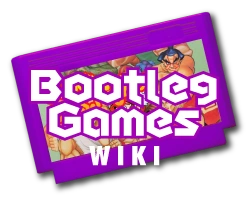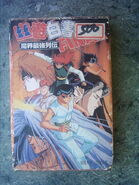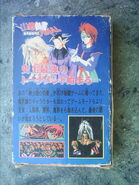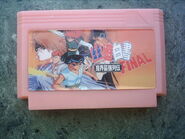No edit summary |
(Adding categories) |
||
| (32 intermediate revisions by 16 users not shown) | |||
| Line 1: | Line 1: | ||
{{Infobox game |
{{Infobox game |
||
| − | |name = Yuu Yuu Hakusho Final |
+ | |name = Yuu Yuu Hakusho Final |
| − | |image = File:YuuYuuHakushoFinalTitle.png |
+ | |image = File:YuuYuuHakushoFinalTitle.png |
| − | |caption = Yuu Yuu Hakusho Final's (Chinese version) title screen |
+ | |caption = Yuu Yuu Hakusho Final's (Chinese version) title screen. |
| − | |publisher |
+ | |publisher = [[Ka Sheng]] |
| − | |developer= |
+ | |developer = [[Hummer Team]] |
| − | |console=Famicom |
+ | |console = Famicom |
| − | |date = 1996 |
+ | |date = 1996 |
| − | |engine = [[Street Fighter II |
+ | |engine = [[Street Fighter II Engine]] |
| − | |sound= Hummer |
+ | |sound = [[Hummer Sound Engine]] |
| − | |alt= Mortal Kombat 6 |
+ | |alt = ''Mortal Kombat 6''<br>''Mortal Kombat 7''<br>''Yuu Yuu Hakusho '97 V'' |
| + | }} |
||
| − | + | '''''Yuu Yuu Hakusho Final''''' is a Famicom port of the Super Famicom game of the same name, made by [[Hummer Team]] and released by [[Ka Sheng]] in 1996. |
|
| ⚫ | |||
| − | [[File:YuuYuuHakushoFinalGameplay.png|thumb|left|192px|Yuu Yuu Hakusho Final's Gameplay]]Like Harry's Legend, there are Chinese and English versions of the game. This is slightly odd though, given that there was no English version of the original game. Also, unlike Harry's Legend the cutscenes are in Chinese in the Chinese version. The English version is credited to NT (most likely the publisher of that version) and the character's names during gameplay are in Chinese, suggesting that this version was released afterwards. The translation for the English version seems to be done from scratch as a result of this, and the translation itself is surprisingly accurate for a pirate. Like in [[Final Fight 3]] many words are hyphenated in the cutscenes, although there is use of punctuation in this game. |
||
| ⚫ | In the |
||
| ⚫ | |||
| − | The graphics are taken from the original Super Famicom game and simplified. The music is mainly taken from it as well, although one track is remixed from [[Street Fighter II (Famicom)|Street Fighter II]] and another from [[Street Fighter IV]]. The ending music from Super Mario Kart is reused from [[Kart Fighter]]. |
||
| + | [[File:YuuYuuHakushoFinalGameplay.png|thumb|left|150px|''Yuu Yuu Hakusho Final''<nowiki>'</nowiki>s gameplay.]] |
||
| + | There are Chinese and English versions of the game. This is slightly odd though, given that the original game was only released in Japanese. Due to this, the translations are seemingly done from scratch, and are surprisingly accurate for a pirate. Both versions are credited to [[Ka Sheng|NT]] (most likely the publisher), although only its Chinese name, Ka Sheng (卡聖) appears in the Chinese version. The characters' names during gameplay in the English version are in Chinese due to lack of space in the HUD, suggesting that this version was released afterwards. Like in ''[[Final Fight 3]]'' many words are hyphenated in the cutscenes, although there is use of punctuation in this game. |
||
| ⚫ | In the Story Mode there are 4 different characters to choose from, but they all use the same cutscenes. If the player loses a fight during the story and chooses to continue, they can change the character that they play as. Cutscenes precede the first 5 fights, although strangely the game ends with a simple "The End" screen. There is also a Contest mode , but this is oddly compatible with two players. These modes have 8 playable characters in the Chinese version and 7 in the English version due to memory. (Chinese version is 640 KB, English version is 384 KB) There are also 3 levels of difficulty for the 1-player modes. |
||
| + | The graphics are taken from the original Super Famicom game and simplified. The music is was also taken from this game but many of the other tracks appear to be reused in Hummer's game (and some remixed): |
||
| ⚫ | |||
| + | *Remix of Ryu's theme from [[Street Fighter II: The World Warrior|''Street Fighter II: The World Warrior'']]. |
||
| ⚫ | |||
| + | *Remix of Musashi's theme from [[Street Fighter IV|''Street Fighter IV'']]. |
||
| − | *The game has another version, named Yuu Yuu Hakusho 97 V. This is copyrighted to KenSheng with a 1997 date. |
||
| + | *Krauser's stage from [[Garou Densetsu Special|''Garou Densetsu Special'']]. |
||
| + | *Remix of Ryo's stage from [[Garou Densetsu Special|''Garou Densetsu Special'']]. This track appears to be broken in all versions of the game with the Square 1 channel beeping at a specific point and then either playing random notes or stopping completely. |
||
| + | |||
| + | == Versions == |
||
| + | Note: All these versions are based off of the English version of the game and were published by Ka Sheng. |
||
| + | *''Mortal Kombat 7'' - Published in 1996. This appears to only be a title hack of the original English version. |
||
| + | *''Yuu Yuu Hakusho '97 V'' - Published in 1997. This version removes the intro and the story mode, but adds duplicates to the select screen. |
||
| + | *''Mortal Kombat 6'' - Published in 1997. This appears to only be a title hack of ''Yuu Yuu Hakusho '97 V''. Should not be confused for the hack of ''Garou Densetsu Special'' that goes by the same name. (Strangely enough, the title screen for that hack is similar to the ''Mortal Kombat 7'' hack of this game.) |
||
| + | |||
| + | == Gallery == |
||
| + | <gallery> |
||
| + | 21909966298494 524.JPG|Box Front. |
||
| + | 21909966298494_185.JPG|Box Back. |
||
| + | 21909966298494_899.JPG|Cartridge. |
||
| + | </gallery> |
||
| + | |||
| ⚫ | |||
| ⚫ | |||
| + | *In the Chinese version, half of the word "TEAM" can be seen in the CHR (tiles 18427 to 18430). In the English version this was overwritten with the English "N.T" text. This may be part of a deleted credit to the developer (possibly Hummer Team) or a remnant from a removed team battle mode. |
||
[[Category:Games]] |
[[Category:Games]] |
||
| ⚫ | |||
[[Category:Famicom/NES games]] |
[[Category:Famicom/NES games]] |
||
| ⚫ | |||
| + | [[Category:Hummer Team]] |
||
| + | [[Category:Based on anime]] |
||
| + | [[Category:Based on a TV Show]] |
||
| + | [[Category:1996 video games]] |
||
| + | [[Category:Ports]] |
||
Latest revision as of 16:59, 29 October 2019
Yuu Yuu Hakusho Final is a Famicom port of the Super Famicom game of the same name, made by Hummer Team and released by Ka Sheng in 1996.
Overview
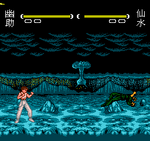
Yuu Yuu Hakusho Final's gameplay.
There are Chinese and English versions of the game. This is slightly odd though, given that the original game was only released in Japanese. Due to this, the translations are seemingly done from scratch, and are surprisingly accurate for a pirate. Both versions are credited to NT (most likely the publisher), although only its Chinese name, Ka Sheng (卡聖) appears in the Chinese version. The characters' names during gameplay in the English version are in Chinese due to lack of space in the HUD, suggesting that this version was released afterwards. Like in Final Fight 3 many words are hyphenated in the cutscenes, although there is use of punctuation in this game. In the Story Mode there are 4 different characters to choose from, but they all use the same cutscenes. If the player loses a fight during the story and chooses to continue, they can change the character that they play as. Cutscenes precede the first 5 fights, although strangely the game ends with a simple "The End" screen. There is also a Contest mode , but this is oddly compatible with two players. These modes have 8 playable characters in the Chinese version and 7 in the English version due to memory. (Chinese version is 640 KB, English version is 384 KB) There are also 3 levels of difficulty for the 1-player modes.
The graphics are taken from the original Super Famicom game and simplified. The music is was also taken from this game but many of the other tracks appear to be reused in Hummer's game (and some remixed):
- Remix of Ryu's theme from Street Fighter II: The World Warrior.
- Remix of Musashi's theme from Street Fighter IV.
- Krauser's stage from Garou Densetsu Special.
- Remix of Ryo's stage from Garou Densetsu Special. This track appears to be broken in all versions of the game with the Square 1 channel beeping at a specific point and then either playing random notes or stopping completely.
Versions
Note: All these versions are based off of the English version of the game and were published by Ka Sheng.
- Mortal Kombat 7 - Published in 1996. This appears to only be a title hack of the original English version.
- Yuu Yuu Hakusho '97 V - Published in 1997. This version removes the intro and the story mode, but adds duplicates to the select screen.
- Mortal Kombat 6 - Published in 1997. This appears to only be a title hack of Yuu Yuu Hakusho '97 V. Should not be confused for the hack of Garou Densetsu Special that goes by the same name. (Strangely enough, the title screen for that hack is similar to the Mortal Kombat 7 hack of this game.)
Gallery
Trivia
- When the fight ends, a repeated sound effect plays indicating score bonuses, despite there being no score in the game. This could mean the game used another one as a base.
- In the Chinese version, half of the word "TEAM" can be seen in the CHR (tiles 18427 to 18430). In the English version this was overwritten with the English "N.T" text. This may be part of a deleted credit to the developer (possibly Hummer Team) or a remnant from a removed team battle mode.
